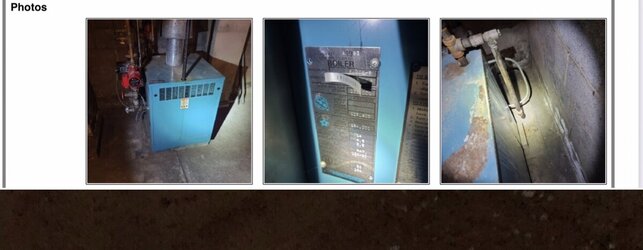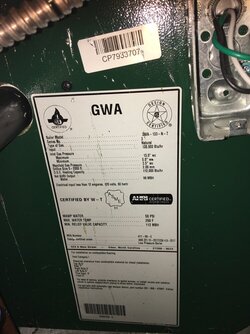Ok…you got me…i think that’s carbon dioxide. I haven’t seen a periodic table in years and didn’t love chemistryNot to be a stickler for wording, but there's only one oxygen atom in a CO molecule.
Conflicting Info & Opinions
- Thread starter Racine16
- Start date
-
Active since 1995, Hearth.com is THE place on the internet for free information and advice about wood stoves, pellet stoves and other energy saving equipment.
We strive to provide opinions, articles, discussions and history related to Hearth Products and in a more general sense, energy issues.
We promote the EFFICIENT, RESPONSIBLE, CLEAN and SAFE use of all fuels, whether renewable or fossil.
You are using an out of date browser. It may not display this or other websites correctly.
You should upgrade or use an alternative browser.
You should upgrade or use an alternative browser.
gthomas785
Minister of Fire
Lol…I knew that I’m just stressed and brain dead…I’m much better at biology or biochemistry if we are talking chemistry…lolHaha I was actually jabbing at Millbilly's use of the word molecule instead of atom, but to clarify further:
CO is carbon monoxide - the dangerous one
CO2 is carbon dioxide - nontoxic and makes up about 0.02% of air that we breathe
So the plumber said my chimney is tile lined and fine as is…the inspector was talking about the possibility of it needing a flue…he asked the plumber to just send him a letter with the specs. the plumber says we don’t need a glue…the tile lined chimney is fine because it’s a natural gas boiler and has always been…never oilYes I would think so. I don't know about the rules where you live but in my area the plumber who installs it should perform a combustion test and a draft measurement. If all of those are in spec for the appliance then you are good to go. If the liner is indeed too small then the draft reading will be low.
Since you mentioned being concerned about carbon monoxide I would recommend getting a CO detector and put it near thefurnaceboiler. That way if you do happen to have any draft issues you will know immediately.
they use the same orange clay tile liners for Oil as well ng or propane. They also work fine for solid fuel appliances provided they are properly taken care of each year. The issues that arised when the more efficient units came out and the no standing pilot light are that the residue of elements left in the flue from combustion combined with moisture create an acid that leaches the lime out of the mortar joints- hence failure of the system. This became a widespread problem throughout the northern tier of states due to condensation within the flue from normal temperature swings throughout the years. Everything was fine until the newer on demand spark ignition systems came about. The old standing pilot flame/s kept just enough heat in the flue to ward off the condensation problems for eons. Thus ends our history lesson for today. The only good way to determine the condition of the flue/s is with a camera system fed up or down the flue. The remediation requires , in most cases, removal of the clay tile liner and the installation of a new stainless steel liner. It is a expensive job. Removing the portion of the flue / chimney above the roof line is also expensive- but in lew of that just sealing it off from the elements would suffice if going with a 90+ efficient unit that vents out the side wall. The perfect time to do removal would be when replacing the roofing materials ( as in a complete tear off).
Last edited:
Thanks for the info! I have to say I’m certainly learning a lot. We have no plans in replacing the roof at this point…we will be replacing some masonry at the top of the chimney. Hopefully the clay tiles are in good enough shape because we are bleeding money and there seems to be the possibility that the current width of that side of the chimney may not be large enough for the correct size metal flue liner we would need. I’m not sure about the pilot flame the previous or current boiler but it was 30 years old…here are both.they use the same orange clay tile liners for Oil as well ng or propane. They also work fine for solid fuel appliances provided they are properly taken care of each year. The issues that arised when the more efficient units came out and the no standing pilot light are that the residue of elements left in the flue from combustion combined with moisture create an acid that leaches the lime out of the mortar joints- hence failure of the system. This became a widespread problem throughout the northern tier of states due to condensation within the flue from normal temperature swings throughout the years. Everything was fine until the newer on demand spark ignition systems came about. The old standing pilot flame/s kept just enough heat in the flue to ward off the condensation problems for eons. Thus ends our history lesson for today. The only good way to determine the condition of the flue/s is with a camera system fed up or down the flue. The remediation requires , in most cases, removal of the clay tile liner and the installation of a new stainless steel liner. It is a expensive job. Removing the portion of the flue / chimney above the roof line is also expensive- but in lew of that just sealing it off from the elements would suffice if going with a 90+ efficient unit that vents out the side wall. The perfect time to do removal would be when replacing the roofing materials ( as in a complete tear off).


your old boiler may or may not have had a standing pilot. ( standing pilot - small pilot light always burning) My hot water heater, 1991 vintage, ( yep 1991 was it's install date) is a standing pilot light unit. I should replace it just because of age ( keep expecting to come home to a flooded basement.)- but it still works - propane fired.
New ones are expensive and do not last much beyond 10 years if that.
Couple quickies : a home, is a hole in the ground into which one pours money. Boat hole in water- same- car camper truck ect portable hole-same
New ones are expensive and do not last much beyond 10 years if that.
Couple quickies : a home, is a hole in the ground into which one pours money. Boat hole in water- same- car camper truck ect portable hole-same
Lol…truth. My hot water heater is only 5 years old so I’m hoping to get some life out of that since every single thing in the entire house in ancient. I just finished replacing a sump pump that looked to be rigged with a garden hose and added a second and a french drain…was in the middle of that mess when we had all the flash floods up here a few weeks ago…just bleeding money. If the central air units die I may have to temporarily do window units until I get some cash up. Heat was a priority with a 30 year old unit and cold winter comingyour old boiler may or may not have had a standing pilot. ( standing pilot - small pilot light always burning) My hot water heater, 1991 vintage, ( yep 1991 was it's install date) is a standing pilot light unit. I should replace it just because of age ( keep expecting to come home to a flooded basement.)- but it still works - propane fired.
New ones are expensive and do not last much beyond 10 years if that.
Couple quickies : a home, is a hole in the ground into which one pours money. Boat hole in water- same- car camper truck ect portable hole-same
Similar threads
- Replies
- 0
- Views
- 554
- Replies
- 1
- Views
- 199
- Replies
- 4
- Views
- 2K
- Replies
- 9
- Views
- 617
- Replies
- 1
- Views
- 440

